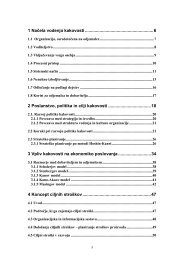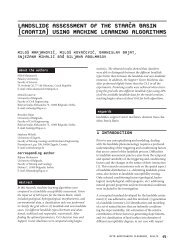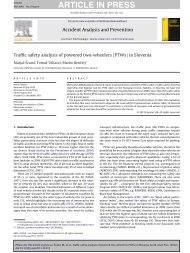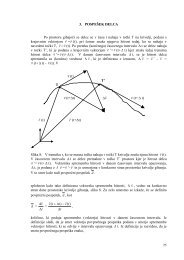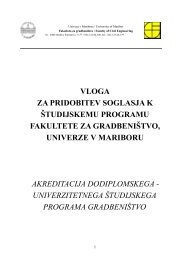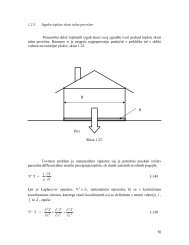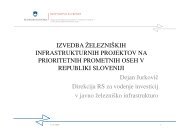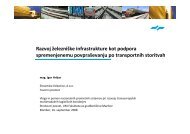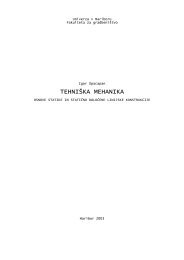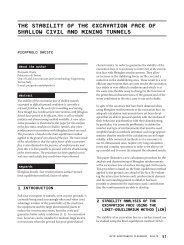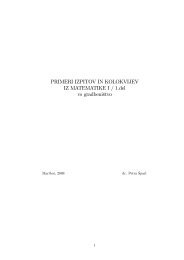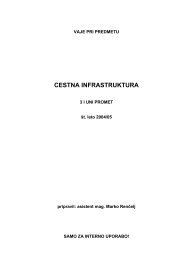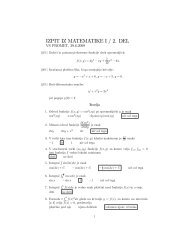Advances and uncertainties in the design of anchored retaining ...
Advances and uncertainties in the design of anchored retaining ...
Advances and uncertainties in the design of anchored retaining ...
You also want an ePaper? Increase the reach of your titles
YUMPU automatically turns print PDFs into web optimized ePapers that Google loves.
ADVANCES AND UNCERTAINTIES IN THE<br />
DESIGN OF ANCHORED RETAINING WALLS<br />
USING NUMERICAL MODELLING<br />
ANTUN SZAVITS NOSSAN<br />
About <strong>the</strong> author<br />
Antun Szavits Nossan<br />
University <strong>of</strong> Zagreb,<br />
Faculty <strong>of</strong> Civil Eng<strong>in</strong>eer<strong>in</strong>g<br />
Kačićeva 26, 10 000 Zagreb, Croatia<br />
E-mail: szavits@grad.hr<br />
Abstract<br />
This paper describes research on <strong>the</strong> prediction <strong>of</strong> horizontal<br />
displacements <strong>and</strong> <strong>in</strong>ternal forces <strong>in</strong> an <strong>anchored</strong><br />
wall for <strong>the</strong> protection <strong>of</strong> an excavation, us<strong>in</strong>g st<strong>and</strong>ard<br />
field <strong>and</strong> laboratory tests <strong>and</strong> a f<strong>in</strong>ite-element programme<br />
with a soil model that can simulate <strong>the</strong> key aspects <strong>of</strong><br />
soil behaviour at a construction site. It is important to<br />
be acqua<strong>in</strong>ted with <strong>the</strong> constitutive model <strong>in</strong>corporated<br />
<strong>in</strong> <strong>the</strong> programme, <strong>and</strong> <strong>the</strong> selection <strong>of</strong> <strong>the</strong> appropriate<br />
soil parameters for <strong>the</strong> numerical analysis is a crucial<br />
part <strong>of</strong> <strong>the</strong> modell<strong>in</strong>g. As a result, it is useful to carry out<br />
numerical simulations <strong>of</strong> st<strong>and</strong>ard laboratory tests with<br />
well-known soil behaviour <strong>in</strong> order to select <strong>the</strong> relevant<br />
parameters for <strong>the</strong> simulation <strong>of</strong> <strong>the</strong> actual construction<br />
process.<br />
It is shown <strong>in</strong> this paper that <strong>the</strong> measurements <strong>of</strong> <strong>the</strong><br />
shear-wave velocities, which can provide <strong>the</strong> soil’s stiffness<br />
at very small stra<strong>in</strong>s, can also be useful for determ<strong>in</strong><strong>in</strong>g<br />
<strong>the</strong> static stiffness at a magnitude <strong>of</strong> <strong>the</strong> stra<strong>in</strong>s relevant for<br />
<strong>the</strong> geotechnical structure under consideration, for both<br />
cohesive <strong>and</strong> noncohesive soils.<br />
The research was carried out by a detailed analysis <strong>of</strong> a<br />
case history <strong>in</strong>volv<strong>in</strong>g an <strong>anchored</strong>, re<strong>in</strong>forced concrete<br />
wall support<strong>in</strong>g <strong>the</strong> walls <strong>of</strong> an excavation <strong>in</strong> a relatively<br />
stiff soil. The wall displacements were monitored us<strong>in</strong>g an<br />
<strong>in</strong>stalled <strong>in</strong>cl<strong>in</strong>ometer.<br />
The major part <strong>of</strong> <strong>the</strong> paper is devoted to an analysis <strong>of</strong> <strong>the</strong><br />
selection <strong>of</strong> parameters, especially <strong>the</strong> stiffness parameters.<br />
The simulation <strong>of</strong> <strong>the</strong> triaxial, consolidated, undra<strong>in</strong>ed<br />
tests was used <strong>in</strong> order to assess <strong>the</strong> reduction <strong>of</strong> <strong>the</strong> secant<br />
stiffness modulus with an <strong>in</strong>crease <strong>of</strong> <strong>the</strong> relative mobilized<br />
shear strength for <strong>the</strong> hard clay layer accord<strong>in</strong>g to <strong>the</strong><br />
published empirical evidence. It is shown that by select<strong>in</strong>g<br />
<strong>the</strong> appropriate stiffness parameters for <strong>the</strong> soil model used<br />
<strong>in</strong> <strong>the</strong> numerical analysis, it is possible to get an acceptable<br />
prediction <strong>of</strong> <strong>the</strong> <strong>anchored</strong>-wall displacements. This is just<br />
one example <strong>of</strong> a successful analysis, but it is encourag<strong>in</strong>g<br />
<strong>in</strong> <strong>the</strong> way that it shows how it is possible to make reliable<br />
predictions based on st<strong>and</strong>ard field <strong>and</strong> laboratory tests<br />
<strong>and</strong> with <strong>the</strong> use <strong>of</strong> an available computer programme<br />
with a realistic soil model.<br />
Keywords<br />
<strong>anchored</strong> wall, soil model, shear stiffness, numerical<br />
modell<strong>in</strong>g, measured displacements<br />
1 INTRODUCTION<br />
Anchored, reta<strong>in</strong>ed structures are <strong>of</strong>ten used as temporary<br />
protection for deep excavations <strong>in</strong> urban areas.<br />
Their role is to ensure <strong>the</strong> stability <strong>of</strong> <strong>the</strong> soil around <strong>the</strong><br />
excavation <strong>and</strong> to prevent any damage to surround<strong>in</strong>g<br />
build<strong>in</strong>gs that might be caused by <strong>the</strong> excavation. The<br />
successful <strong>design</strong> <strong>of</strong> such structures depends a great deal<br />
on a realistic solution to <strong>the</strong> <strong>in</strong>teraction between <strong>the</strong><br />
structure, <strong>the</strong> anchors <strong>and</strong> <strong>the</strong> soil, tak<strong>in</strong>g <strong>in</strong>to consideration<br />
<strong>the</strong> mechanical characteristics <strong>of</strong> <strong>the</strong> surround<strong>in</strong>g<br />
soil as well as <strong>the</strong> manner <strong>and</strong> <strong>the</strong> sequence <strong>of</strong> <strong>the</strong><br />
construction. Gaba et al. [1] gave an overview <strong>of</strong> <strong>the</strong><br />
available numerical methods, toge<strong>the</strong>r with an assessment<br />
<strong>of</strong> <strong>the</strong>ir advantages <strong>and</strong> drawbacks. A detailed<br />
solution to <strong>the</strong> <strong>in</strong>teraction problems is becom<strong>in</strong>g<br />
<strong>in</strong>creas<strong>in</strong>gly more accessible with <strong>the</strong> use <strong>of</strong> commercial,<br />
numerical tools based primarily on <strong>the</strong> f<strong>in</strong>ite-element<br />
method, which allows for <strong>the</strong> use <strong>of</strong> complex, constitutive<br />
soil models [2], [3]. There are, however, serious<br />
problems with <strong>the</strong> practical use <strong>of</strong> <strong>the</strong>se tools. Schweiger<br />
[4] describes a detailed benchmark<strong>in</strong>g experiment <strong>in</strong><br />
which several experts were <strong>in</strong>vited to numerically model<br />
<strong>the</strong> behaviour <strong>of</strong> an <strong>anchored</strong> diaphragm wall. The<br />
results were scattered over an alarm<strong>in</strong>gly wide range,<br />
which is not acceptable <strong>in</strong> practice, due to <strong>the</strong> selection<br />
<strong>of</strong> different constitutive models <strong>and</strong> soil parameters.<br />
De Vos <strong>and</strong> Whenham [5] have shown <strong>the</strong> results <strong>of</strong> a<br />
survey among a large number <strong>of</strong> users <strong>of</strong> geotechnical<br />
ACTA GEOTECHNICA SLOVENICA, 2008/1 5.
A. S. NOSSAN: ADVANCES AND UNCERTAINTIES IN THE DESIGN OF ANCHORED RETAINING WALLS USING NUMERICAL MODELLING<br />
f<strong>in</strong>ite-element programmes that show <strong>the</strong> problems<br />
<strong>the</strong>y were encounter<strong>in</strong>g. The first item on <strong>the</strong> list <strong>of</strong><br />
problems is <strong>the</strong> determ<strong>in</strong>ation <strong>of</strong> soil parameters (23%<br />
<strong>of</strong> answers), followed by <strong>the</strong> determ<strong>in</strong>ation <strong>of</strong> <strong>the</strong> <strong>in</strong>itial<br />
conditions <strong>in</strong> <strong>the</strong> soil, <strong>the</strong> selection <strong>of</strong> <strong>the</strong> constitutive<br />
soil model, <strong>the</strong> <strong>in</strong>terpretation <strong>of</strong> <strong>the</strong> results, <strong>the</strong> numerical<br />
discretization, <strong>the</strong> boundary conditions <strong>and</strong> <strong>the</strong><br />
selection <strong>of</strong> <strong>the</strong> type <strong>of</strong> analysis. The first three items<br />
represent <strong>the</strong> core <strong>of</strong> <strong>the</strong> geotechnical <strong>design</strong>, supported<br />
by numerical modell<strong>in</strong>g, <strong>and</strong> so <strong>the</strong>y appeared at <strong>the</strong> top<br />
<strong>of</strong> <strong>the</strong> list <strong>in</strong> more than 50% <strong>of</strong> <strong>the</strong> answers. Gaba et al.<br />
[1] state, among o<strong>the</strong>rs, <strong>the</strong> follow<strong>in</strong>g reasons for <strong>the</strong>se<br />
problems: <strong>the</strong> <strong>in</strong>adequate constitutive models, where <strong>the</strong><br />
simple ones are not realistic; <strong>the</strong> data on soil strength;<br />
<strong>the</strong> stiffness <strong>and</strong> <strong>in</strong>itial stresses that are not <strong>of</strong> sufficient<br />
quality; <strong>the</strong> <strong>in</strong>sufficient user experience with <strong>the</strong> particular<br />
programme; <strong>and</strong> <strong>the</strong> <strong>in</strong>adequate modell<strong>in</strong>g <strong>of</strong> <strong>the</strong><br />
undra<strong>in</strong>ed conditions <strong>in</strong> cohesive soils. They claim that<br />
“Ground movements cannot be predicted accurately. It<br />
is essential that optimum use is made <strong>of</strong> precedent <strong>in</strong><br />
comparable conditions through <strong>the</strong> use <strong>of</strong> good-quality<br />
case-history data. Case-history-based empirical methods<br />
<strong>of</strong> prediction are to be preferred to <strong>the</strong> use <strong>of</strong> complex<br />
analyses, unless such analyses are first calibrated aga<strong>in</strong>st<br />
reliable measurements <strong>of</strong> well-monitored comparable<br />
excavations <strong>and</strong> wall systems.” In any case, f<strong>in</strong>ite-element<br />
analyses should be used with caution, but <strong>the</strong>y rema<strong>in</strong><br />
<strong>the</strong> only tool <strong>in</strong> cases <strong>of</strong> unusual structures for which<br />
<strong>the</strong>re is no comparable experience.<br />
Studies <strong>in</strong> which complex numerical models are<br />
calibrated aga<strong>in</strong>st <strong>the</strong> monitor<strong>in</strong>g data <strong>of</strong> a case history<br />
can be helpful <strong>in</strong> resolv<strong>in</strong>g <strong>the</strong> above-mentioned problems<br />
related to <strong>the</strong> use <strong>of</strong> commercial f<strong>in</strong>ite-element<br />
programmes for geotechnical structures. This paper<br />
describes such a case history <strong>and</strong> <strong>the</strong> subsequent<br />
numerical modell<strong>in</strong>g. The case history comprises an<br />
excavation protected by an <strong>anchored</strong>, reta<strong>in</strong><strong>in</strong>g structure,<br />
<strong>of</strong> which <strong>the</strong>re are several examples constructed<br />
recently <strong>in</strong> Zagreb, Croatia. St<strong>and</strong>ard geotechnical <strong>in</strong>vestigations<br />
<strong>of</strong> average quality were carried out along with<br />
measurements <strong>of</strong> <strong>the</strong> shear-wave velocities with respect<br />
to depth. It was <strong>in</strong>tended to use <strong>the</strong>se measurements<br />
for <strong>the</strong> prediction <strong>of</strong> <strong>the</strong> <strong>anchored</strong>-wall displacements,<br />
based on <strong>the</strong> significance <strong>of</strong> this aspect <strong>of</strong> soil behaviour,<br />
which has recently ga<strong>in</strong>ed attention [6], related to <strong>the</strong><br />
soil-structure <strong>in</strong>teraction [7] <strong>and</strong> particularly to <strong>the</strong><br />
<strong>in</strong>teraction <strong>of</strong> <strong>the</strong> soil with <strong>the</strong> <strong>anchored</strong> walls [8].<br />
Shear-wave velocities provide a direct <strong>in</strong>-situ measure<br />
<strong>of</strong> <strong>the</strong> soil stiffness without <strong>the</strong> necessity to retrieve<br />
undisturbed soil samples or use problematic correlations.<br />
The <strong>anchored</strong>-wall displacements were monitored<br />
dur<strong>in</strong>g construction, <strong>and</strong> <strong>the</strong> excavation was successfully<br />
completed. Subsequent numerical analyses were carried<br />
6.<br />
ACTA GEOTECHNICA SLOVENICA, 2008/1<br />
out us<strong>in</strong>g <strong>the</strong> f<strong>in</strong>ite-element programme Plaxis V8 [9],<br />
which is widely used <strong>in</strong> Croatia. Its option <strong>of</strong> small stra<strong>in</strong><br />
was used <strong>in</strong> order to take advantage <strong>of</strong> <strong>the</strong> shear-wave<br />
velocity measurements <strong>and</strong> <strong>the</strong> result<strong>in</strong>g soil stiffness at<br />
very small stra<strong>in</strong>s. It was decided, for practical reasons,<br />
to use Plaxis V8, even though sophisticated analyses <strong>of</strong><br />
<strong>anchored</strong> walls at small stra<strong>in</strong>s have been reported [10],<br />
but us<strong>in</strong>g a commercially unavailable programme.<br />
Designers <strong>in</strong> Croatia are familiar with <strong>the</strong> use <strong>of</strong> Plaxis<br />
for modell<strong>in</strong>g <strong>anchored</strong> structures. Their predictions <strong>of</strong><br />
displacements based on <strong>the</strong> st<strong>and</strong>ard recommendations<br />
for <strong>the</strong> selection <strong>of</strong> soil parameters usually turn out as<br />
a significant overestimation <strong>in</strong> comparison with <strong>the</strong><br />
measured wall displacements. As a result <strong>the</strong>y use a<br />
higher soil stiffness, based on <strong>the</strong> argument <strong>of</strong> available<br />
data on similar structures <strong>in</strong> similar soils. This type <strong>of</strong><br />
reason<strong>in</strong>g, which is not based on serious studies, makes<br />
<strong>the</strong> use <strong>of</strong> complex f<strong>in</strong>ite-element calculations questionable,<br />
because <strong>the</strong>y do not seem to have a significant<br />
advantage over, for example, <strong>the</strong> method <strong>of</strong> a beam<br />
rest<strong>in</strong>g on elasto-plastic spr<strong>in</strong>gs, where <strong>the</strong> spr<strong>in</strong>gs’ characteristics<br />
are determ<strong>in</strong>ed empirically from displacement<br />
measurements on similar <strong>anchored</strong> walls.<br />
2 THE CASE HISTORY<br />
The excavation, 14.5 m deep, is located <strong>in</strong> a rapidly<br />
exp<strong>and</strong><strong>in</strong>g commercial area <strong>in</strong> Zagreb, <strong>and</strong> is <strong>in</strong>tended<br />
for <strong>the</strong> construction <strong>of</strong> underground storeys <strong>of</strong> a<br />
commercial build<strong>in</strong>g. An exist<strong>in</strong>g, old, brick house,<br />
sensitive to soil displacements, is located near to <strong>the</strong><br />
excavation. A 17.5-m-high <strong>and</strong> 0.6-m-thick wall <strong>of</strong><br />
re<strong>in</strong>forced concrete, embedded <strong>in</strong> <strong>the</strong> soil 4 m below <strong>the</strong><br />
bottom <strong>of</strong> <strong>the</strong> excavation, provided protection. The wall<br />
was cast <strong>in</strong> place prior to <strong>the</strong> excavation works.<br />
Three rows <strong>of</strong> BBR 1860/1660 pre-stressed ground<br />
anchors were <strong>in</strong>stalled at a horizontal distance <strong>of</strong> 2.5<br />
m <strong>in</strong> each row. The upper, first row anchors consist <strong>of</strong><br />
4 str<strong>and</strong>s <strong>of</strong> high-strength steel, 0.6” <strong>in</strong> diameter. The<br />
second <strong>and</strong> third row anchors consist <strong>of</strong> 5 str<strong>and</strong>s. Each<br />
anchor <strong>in</strong> <strong>the</strong> first two rows was pre-stressed to 500 kN,<br />
whereas <strong>the</strong> anchors <strong>in</strong> <strong>the</strong> third row were pre-stressed<br />
to 650 kN. Incl<strong>in</strong>ometer measurements <strong>of</strong> <strong>the</strong> relative<br />
horizontal wall displacements were taken dur<strong>in</strong>g <strong>the</strong><br />
excavation works. The <strong>in</strong>cl<strong>in</strong>ometer tube was <strong>in</strong>stalled <strong>in</strong><br />
<strong>the</strong> wall concrete along its whole height at <strong>the</strong> location <strong>of</strong><br />
<strong>the</strong> brick house. The vertical excavation section with <strong>the</strong><br />
wall <strong>and</strong> <strong>the</strong> neighbour<strong>in</strong>g house is shown <strong>in</strong> Fig. 1.
A. S. NOSSAN: ADVANCES AND UNCERTAINTIES IN THE DESIGN OF ANCHORED RETAINING WALLS USING NUMERICAL MODELLING<br />
Figure 1. Vertical excavation section, re<strong>in</strong>forced concrete wall with three rows <strong>of</strong> anchors <strong>and</strong> <strong>the</strong> neighbour<strong>in</strong>g brick house.<br />
The ground surface at <strong>the</strong> location is horizontal <strong>and</strong><br />
<strong>the</strong> underly<strong>in</strong>g ground is horizontally layered. The<br />
surface layer is around 2 m thick <strong>and</strong> it consists <strong>of</strong><br />
medium dense fill <strong>and</strong> clay underla<strong>in</strong> by a layer <strong>of</strong> poorly<br />
graduated medium dense gravel down to a depth <strong>of</strong> 14<br />
m. Below this depth is a thick layer <strong>of</strong> hard, overconsolidated<br />
clay. The geotechnical field <strong>in</strong>vestigation was<br />
carried out <strong>in</strong> several 30-m-deep boreholes. Disturbed<br />
<strong>and</strong> undisturbed samples were retrieved <strong>and</strong> SPT<br />
measurements were taken. The shear-wave velocities<br />
were measured <strong>in</strong> two boreholes us<strong>in</strong>g <strong>the</strong> down-hole<br />
method. The underground water level was determ<strong>in</strong>ed<br />
<strong>in</strong> <strong>the</strong> gravel layer at 7 m below <strong>the</strong> ground surface.<br />
St<strong>and</strong>ard classification tests were carried out <strong>in</strong> <strong>the</strong><br />
laboratory on disturbed samples, <strong>and</strong> undisturbed<br />
clay samples were used for <strong>the</strong> triaxial, consolidated,<br />
undra<strong>in</strong>ed (CIU) <strong>and</strong> unconsolidated, undra<strong>in</strong>ed (UU)<br />
tests. The CIU tests were performed with pore-water<br />
pressure measurements <strong>in</strong> order to determ<strong>in</strong>e <strong>the</strong> effective<br />
shear-strength parameters. The undra<strong>in</strong>ed shear<br />
strength was determ<strong>in</strong>ed <strong>in</strong> <strong>the</strong> UU tests <strong>and</strong> with <strong>the</strong><br />
use <strong>of</strong> a pocket penetrometer. The undisturbed clay<br />
samples were also used for oedometer tests. The results<br />
<strong>of</strong> <strong>the</strong> field <strong>and</strong> laboratory tests are presented <strong>in</strong> Fig. 2.<br />
The SPT blow count N was corrected by <strong>the</strong> st<strong>and</strong>ard<br />
hammer impact energy <strong>of</strong> 60% <strong>and</strong> <strong>the</strong> normalized<br />
vertical effective stress, where p ref = 100 kPa, accord<strong>in</strong>g<br />
to Skempton [11]<br />
( N ) = N<br />
1 60 60<br />
ref<br />
p<br />
σ ′<br />
(1)<br />
The full l<strong>in</strong>e <strong>in</strong> Fig. 2 represents <strong>the</strong> selected characteristic<br />
value <strong>of</strong> <strong>the</strong> <strong>design</strong> parameter (N 1 ) 60 accord<strong>in</strong>g<br />
to Eurocode 7 [12]. The same characteristic value <strong>of</strong><br />
v<br />
ACTA GEOTECHNICA SLOVENICA, 2008/1 7.
A. S. NOSSAN: ADVANCES AND UNCERTAINTIES IN THE DESIGN OF ANCHORED RETAINING WALLS USING NUMERICAL MODELLING<br />
this parameter was selected for <strong>the</strong> gravel for reasons<br />
<strong>of</strong> simplicity, even though a larger value could have<br />
been selected for <strong>the</strong> gravel above <strong>the</strong> water level. It<br />
also seemed reasonable to select a unique value <strong>of</strong> this<br />
parameter for <strong>the</strong> entire clay layer.<br />
The characteristic value <strong>of</strong> <strong>the</strong> shear modulus for very<br />
small stra<strong>in</strong>s, G0 , was determ<strong>in</strong>ed from <strong>the</strong> shear-wave<br />
2<br />
velocity through G0= ρv , where ρ is <strong>the</strong> soil density.<br />
s<br />
The distribution <strong>of</strong> this modulus with depth was<br />
assumed accord<strong>in</strong>g to <strong>the</strong> follow<strong>in</strong>g expression<br />
8.<br />
Figure 2. Soil pr<strong>of</strong>ile with <strong>the</strong> f<strong>in</strong>es <strong>and</strong> s<strong>and</strong> content <strong>in</strong> <strong>the</strong> gravel, <strong>the</strong> water content (w 0 ), <strong>the</strong> liquid limit (w L ) <strong>and</strong> <strong>the</strong> plastic limit<br />
(w P ), <strong>the</strong> undra<strong>in</strong>ed shear strength (c u ), <strong>the</strong> corrected SPT blow count (N 1 <strong>and</strong> (N 1 ) 60 ) <strong>and</strong> <strong>the</strong> shear-wave velocity (v s ).<br />
G = G<br />
ref v<br />
0 0<br />
σ ′<br />
ref (2)<br />
p<br />
ref<br />
where G0 is <strong>the</strong> reference shear modulus at a vertical<br />
effective stress <strong>of</strong> 100 kPa. Two dist<strong>in</strong>ct values <strong>of</strong><br />
ref<br />
G0 were allocated to <strong>the</strong> entire layers <strong>of</strong> gravel <strong>and</strong><br />
clay. No such parameter was allocated to <strong>the</strong> th<strong>in</strong> surface<br />
layer because it was assumed that its <strong>in</strong>fluence on <strong>the</strong><br />
behaviour <strong>of</strong> <strong>the</strong> <strong>anchored</strong> wall was negligible. The full<br />
l<strong>in</strong>e <strong>in</strong> Fig. 2 shows <strong>the</strong> <strong>design</strong> characteristic shear-wave<br />
velocities, which result from <strong>the</strong> above assumptions.<br />
ACTA GEOTECHNICA SLOVENICA, 2008/1<br />
The characteristic value <strong>of</strong> <strong>the</strong> effective angle <strong>of</strong> <strong>in</strong>ternal<br />
friction ϕ′ for <strong>the</strong> gravel layer was determ<strong>in</strong>ed through<br />
<strong>the</strong> correlation with ( N1) 60 proposed by Hatanaka <strong>and</strong><br />
Uchida [13]<br />
0 0<br />
ϕ′( )= 20 + 15. 4 ( N ) (3)<br />
1 60<br />
which gives a characteristic value <strong>of</strong> ϕ′ = 35 0 for ( N1) 60= 14 .<br />
Even though this correlation was derived for s<strong>and</strong>y soils,<br />
<strong>the</strong>re were no reliable data for gravel available.<br />
The characteristic values <strong>of</strong> <strong>the</strong> effective cohesion, ′<br />
c , <strong>and</strong><br />
<strong>the</strong> effective angle <strong>of</strong> <strong>in</strong>ternal friction for <strong>the</strong> clay layer<br />
were determ<strong>in</strong>ed by <strong>the</strong> <strong>in</strong>terpretation <strong>of</strong> <strong>the</strong> triaxial<br />
CIU tests. The shear-strength parameters were selected<br />
at <strong>the</strong> po<strong>in</strong>t where <strong>the</strong> ratio <strong>of</strong> <strong>the</strong> major <strong>and</strong> m<strong>in</strong>or<br />
pr<strong>in</strong>cipal effective stresses reaches a maximum. The<br />
test results <strong>and</strong> <strong>the</strong> selected values <strong>of</strong> <strong>the</strong> shear-strength<br />
parameters are shown <strong>in</strong> Fig. 3. The o<strong>the</strong>r characteristic<br />
parameter values depend on <strong>the</strong> selected soil model, <strong>and</strong><br />
<strong>the</strong>ir determ<strong>in</strong>ation will be described <strong>in</strong> <strong>the</strong> next section.
A. S. NOSSAN: ADVANCES AND UNCERTAINTIES IN THE DESIGN OF ANCHORED RETAINING WALLS USING NUMERICAL MODELLING<br />
Figure 3. Clay shear-strength parameters from <strong>the</strong> results <strong>of</strong><br />
<strong>the</strong> CIU tests <strong>and</strong> selected characteristic values. The numbers<br />
connected to <strong>the</strong> symbols represent <strong>the</strong> vertical stra<strong>in</strong>s ε1 (%)<br />
at <strong>the</strong> maximum value <strong>of</strong> σ′ σ′<br />
1 3 .<br />
3 THE SOIL MODEL<br />
The harden<strong>in</strong>g-soil model with <strong>the</strong> option <strong>of</strong> us<strong>in</strong>g<br />
<strong>the</strong> soil stiffness at small stra<strong>in</strong>s was selected from <strong>the</strong><br />
Plaxis V8 programme. This model is described <strong>in</strong> <strong>the</strong><br />
programme manual [9] <strong>and</strong> <strong>in</strong> much more detail by<br />
Schanz et al. [14] <strong>and</strong> Benz [15]. It is described here only<br />
to <strong>the</strong> extent <strong>of</strong> expla<strong>in</strong><strong>in</strong>g <strong>the</strong> selection <strong>of</strong> <strong>the</strong> required<br />
parameters. The orig<strong>in</strong>al harden<strong>in</strong>g model, which did not<br />
have <strong>the</strong> option for small stra<strong>in</strong> stiffness, is described first.<br />
This soil model is <strong>of</strong> <strong>the</strong> elasto-plastic isotropic harden<strong>in</strong>g<br />
type with two harden<strong>in</strong>g laws, each with its own<br />
yield surface <strong>and</strong> plastic potential. It satisfies <strong>the</strong> Mohr-<br />
Coulomb strength criterion with a constant effective<br />
cohesion c ′ <strong>and</strong> a constant effective angle <strong>of</strong> <strong>in</strong>ternal<br />
friction ϕ ′ . The first harden<strong>in</strong>g law is related to shear<br />
(S) with a convex yield surface that crosses <strong>the</strong> Mohr-<br />
Coulomb envelope at <strong>the</strong> po<strong>in</strong>t where <strong>the</strong> deviatoric<br />
stress q = 0 . It is used to model irreversible stra<strong>in</strong>s due<br />
to primary deviatoric load<strong>in</strong>g. The second harden<strong>in</strong>g law<br />
is related to <strong>the</strong> compression (C) <strong>and</strong> it is used to model<br />
irreversible plastic stra<strong>in</strong>s due to primary compression<br />
<strong>in</strong> <strong>the</strong> oedometer load<strong>in</strong>g <strong>and</strong> <strong>the</strong> isotropic load<strong>in</strong>g.<br />
When <strong>the</strong> load<strong>in</strong>g phase results <strong>in</strong> <strong>the</strong> effective stress<br />
path reach<strong>in</strong>g <strong>the</strong> two yield surfaces, <strong>the</strong>y are “dragged”<br />
along with <strong>the</strong> stress path, thus produc<strong>in</strong>g both elastic<br />
<strong>and</strong> plastic stra<strong>in</strong>s. The development <strong>of</strong> <strong>the</strong> plastic<br />
Figure 4. Stress path <strong>and</strong> yield surfaces for <strong>the</strong> harden<strong>in</strong>g model from Plaxis V8 for a soil go<strong>in</strong>g through<br />
its geologic phases <strong>of</strong> sedimentation, overconsolidation <strong>and</strong> triaxial undra<strong>in</strong>ed shear.<br />
ACTA GEOTECHNICA SLOVENICA, 2008/1 9.
A. S. NOSSAN: ADVANCES AND UNCERTAINTIES IN THE DESIGN OF ANCHORED RETAINING WALLS USING NUMERICAL MODELLING<br />
stra<strong>in</strong>s significantly reduces <strong>the</strong> value <strong>of</strong> <strong>the</strong> tangent soil<br />
stiffness compared to its value <strong>in</strong> <strong>the</strong> elastic region. The<br />
yield surfaces do not move dur<strong>in</strong>g <strong>the</strong> unload<strong>in</strong>g phase;<br />
<strong>the</strong>y rema<strong>in</strong> at <strong>the</strong> previously reached location, bound<strong>in</strong>g<br />
<strong>the</strong> elastic region, so that <strong>the</strong> result<strong>in</strong>g stra<strong>in</strong>s are<br />
fully elastic.<br />
Fig. 4 shows <strong>the</strong> stress path <strong>and</strong> <strong>the</strong> yield surfaces for <strong>the</strong><br />
harden<strong>in</strong>g model from Plaxis V8 for a soil go<strong>in</strong>g through<br />
its geologic phases <strong>of</strong> sedimentation, overconsolidation<br />
<strong>and</strong> triaxial undra<strong>in</strong>ed shear; <strong>the</strong> last <strong>of</strong> <strong>the</strong>se be<strong>in</strong>g such<br />
as <strong>the</strong> imposed load<strong>in</strong>g to <strong>the</strong> geotechnical structure<br />
under consideration. The stress path <strong>in</strong> <strong>the</strong> left part <strong>of</strong><br />
Fig. 4 is drawn <strong>in</strong> a ( p ′ , q) diagram, where p′ <strong>and</strong> q are<br />
<strong>the</strong> effective stress <strong>in</strong>variants depend<strong>in</strong>g on <strong>the</strong> vertical,<br />
σ′ v , <strong>and</strong> horizontal, σ′ h , effective stresses. The mean<br />
effective stress p ′ = ( σ′ + ′<br />
v 2σh)/ 3 <strong>and</strong> <strong>the</strong> deviatoric<br />
stress q = σ′ − σ′<br />
v h . MC denotes <strong>the</strong> Mohr-Coulomb<br />
envelope; S1 <strong>and</strong> S2 are two positions <strong>of</strong> <strong>the</strong> shear yield<br />
surface; <strong>and</strong> C1 <strong>and</strong> C2 are two positions <strong>of</strong> <strong>the</strong> compression<br />
yield surface. Dur<strong>in</strong>g sedimentation <strong>the</strong> soil follows<br />
<strong>the</strong> stress path from po<strong>in</strong>t (1) to po<strong>in</strong>t (2). When it is at<br />
<strong>the</strong> po<strong>in</strong>t (1'), for example, on yield surfaces C1 <strong>and</strong> S1 ,<br />
both <strong>the</strong> yield surfaces are “dragged” with <strong>the</strong> stress path<br />
to <strong>the</strong> new positions denoted by C2 <strong>and</strong> S2 to <strong>the</strong> po<strong>in</strong>t<br />
(2). The geologic unload<strong>in</strong>g from po<strong>in</strong>t (2) to po<strong>in</strong>t (3)<br />
leads to <strong>the</strong> actual overconsolidated state <strong>of</strong> <strong>the</strong> soil. The<br />
yield surfaces rema<strong>in</strong> at <strong>the</strong>ir positions C2 <strong>and</strong> S2 . The<br />
undra<strong>in</strong>ed shear phase is shown by <strong>the</strong> stress path from<br />
po<strong>in</strong>t (3) to po<strong>in</strong>t (5). At po<strong>in</strong>t (4) it reaches <strong>the</strong> yield<br />
surface S2, thus produc<strong>in</strong>g plastic deformations <strong>and</strong> a<br />
reduction <strong>of</strong> <strong>the</strong> soil stiffness, which is demonstrated <strong>in</strong><br />
<strong>the</strong> right part <strong>of</strong> Fig. 4 by a significant <strong>in</strong>crease <strong>in</strong> <strong>the</strong><br />
vertical deformation ε1 from po<strong>in</strong>t (4) to po<strong>in</strong>t (5).<br />
The slope <strong>of</strong> <strong>the</strong> Mohr-Coulomb envelope for triaxial<br />
compression is given by<br />
6s<strong>in</strong>ϕ′<br />
M =<br />
3−<br />
s<strong>in</strong>ϕ<br />
′<br />
(4)<br />
<strong>and</strong> <strong>the</strong> envelope crosses <strong>the</strong> p′ axis at <strong>the</strong> po<strong>in</strong>t with <strong>the</strong><br />
coord<strong>in</strong>ate<br />
′ =− ′ c<br />
p<br />
q= 0 tanϕ ′<br />
(5)<br />
This complex behaviour is, however, governed by <strong>the</strong><br />
soil parameters, which are familiar <strong>in</strong> geotechnical<br />
practice. The user has to def<strong>in</strong>e <strong>the</strong> Mohr-Coulomb<br />
strength parameters c′ <strong>and</strong> ϕ ′ , <strong>the</strong> angle <strong>of</strong> dilatancy<br />
at <strong>the</strong> dra<strong>in</strong>ed failure ψ , <strong>the</strong> three reference values<br />
<strong>of</strong> <strong>the</strong> Young’s modulus, <strong>the</strong> power coefficient for <strong>the</strong><br />
determ<strong>in</strong>ation <strong>of</strong> <strong>the</strong> soil stiffness, <strong>and</strong> some additional<br />
10. ACTA GEOTECHNICA SLOVENICA, 2008/1<br />
advanced parameters, which can be left at <strong>the</strong>ir default<br />
sett<strong>in</strong>gs.<br />
Rowe’s stress-<strong>in</strong>duced dilatancy <strong>the</strong>ory is used <strong>in</strong> <strong>the</strong><br />
model for <strong>the</strong> determ<strong>in</strong>ation <strong>of</strong> <strong>the</strong> volumetric plastic<br />
stra<strong>in</strong>s dur<strong>in</strong>g shear load<strong>in</strong>g. Accord<strong>in</strong>g to this <strong>the</strong>ory,<br />
<strong>the</strong> material behaviour is governed by <strong>the</strong> critical state<br />
friction angle ϕcv , which is <strong>the</strong> slope <strong>of</strong> <strong>the</strong> Mohr-<br />
Coulomb envelope correspond<strong>in</strong>g to <strong>the</strong> critical state<br />
l<strong>in</strong>e <strong>in</strong> <strong>the</strong> ( p ′ , q) diagram. The material contracts for <strong>the</strong><br />
values <strong>of</strong> <strong>the</strong> mobilized friction angle smaller than ϕcv ,<br />
whereas it dilates for values higher thanϕ cv . At <strong>the</strong> po<strong>in</strong>t<br />
<strong>of</strong> failure, <strong>the</strong> mobilized friction angle equals ϕ ′ , <strong>and</strong><br />
<strong>the</strong> angle <strong>of</strong> dilatancy is determ<strong>in</strong>ed from<br />
s<strong>in</strong>ϕ′−s<strong>in</strong>ϕ s<strong>in</strong>ψ<br />
=<br />
1−<br />
s<strong>in</strong>ϕ′ s<strong>in</strong>ϕ<br />
cv<br />
cv<br />
(6)<br />
The soil stiffness is determ<strong>in</strong>ed through <strong>the</strong> reference<br />
ref ref<br />
values <strong>of</strong> E for <strong>the</strong> elastic stiffness, E50 for <strong>the</strong> secant<br />
ur<br />
stiffness at 50% <strong>of</strong> <strong>the</strong> mobilized compressive strength<br />
ref<br />
<strong>in</strong> <strong>the</strong> st<strong>and</strong>ard dra<strong>in</strong>ed triaxial test, <strong>and</strong> Eoed for <strong>the</strong><br />
tangent oedometer modulus dur<strong>in</strong>g <strong>the</strong> load<strong>in</strong>g <strong>of</strong> a<br />
normally consolidated soil <strong>in</strong> an oedometer test. These<br />
reference values are related to <strong>the</strong> reference conf<strong>in</strong><strong>in</strong>g<br />
<strong>the</strong> effective stress σ′ 3 = p = 100<br />
ref<br />
kPa. The values <strong>of</strong><br />
<strong>the</strong> three Young’s moduli for different conf<strong>in</strong><strong>in</strong>g effective<br />
stresses are def<strong>in</strong>ed by<br />
E = E<br />
ref<br />
ur ur<br />
E = E<br />
ref<br />
50 50<br />
E = E<br />
ref<br />
oed oed<br />
⎛<br />
⎜ c′<br />
cosϕ′+ σ′ ′ ⎞<br />
3 s<strong>in</strong>ϕ<br />
⎜<br />
ref<br />
⎝⎜<br />
c′ cosϕ′+ p s<strong>in</strong>ϕ′<br />
⎠⎟<br />
⎛<br />
⎜ c′<br />
cosϕ′+ σ′ ′<br />
3 s<strong>in</strong>ϕ<br />
⎞<br />
⎜<br />
ref<br />
⎝⎜<br />
c′ cosϕ′+ p s<strong>in</strong>ϕ′<br />
⎠⎟<br />
⎛<br />
⎜ c′<br />
cosϕ′+ σ′ ′ ⎞<br />
3 s<strong>in</strong>ϕ<br />
⎜<br />
ref<br />
⎝⎜<br />
c′ cosϕ′+ p s<strong>in</strong>ϕ′<br />
⎠⎟<br />
m<br />
m<br />
m<br />
(7)<br />
(8)<br />
(9)<br />
where m is <strong>the</strong> power coefficient def<strong>in</strong>ed by <strong>the</strong> user.<br />
The advanced parameters <strong>in</strong>clude Poisson’s ratio, νur , for<br />
which <strong>the</strong> default value is set at 0.2, which corresponds<br />
to numerous published recommendations, <strong>the</strong> coefficient<br />
<strong>of</strong> <strong>the</strong> earth pressure at rest for normally consoli-<br />
nc<br />
dated soil K 0 , with <strong>the</strong> default value determ<strong>in</strong>ed from<br />
nc<br />
K 0 = 1−<br />
s<strong>in</strong>ϕ ′ , <strong>and</strong> <strong>the</strong> failure ratio Rf with <strong>the</strong> default<br />
value <strong>of</strong> 0.9.<br />
The basic idea for <strong>the</strong> formulation <strong>of</strong> <strong>the</strong> harden<strong>in</strong>g-soil<br />
model is <strong>the</strong> hyperbolic relationship between <strong>the</strong> vertical<br />
stra<strong>in</strong> ε 1 <strong>and</strong> <strong>the</strong> deviatoric stress q dur<strong>in</strong>g <strong>the</strong> st<strong>and</strong>ard
isotropically consolidated dra<strong>in</strong>ed shear, which can be<br />
approximated by<br />
ε 1<br />
2<br />
≈<br />
2 1<br />
− Rf<br />
q<br />
E q<br />
50 −<br />
q a<br />
(10)<br />
where qa is <strong>the</strong> asymptotic value <strong>of</strong> <strong>the</strong> shear strength,<br />
related to <strong>the</strong> deviatoric stress at failure, q , through<br />
f<br />
qa q R = f f, <strong>and</strong> <strong>the</strong> deviatoric stress at failure is def<strong>in</strong>ed by<br />
2s<strong>in</strong>ϕ′<br />
qf = ( ccot<br />
ϕ′ + σ′<br />
3)<br />
1−<br />
s<strong>in</strong>ϕ′<br />
(11)<br />
The recently developed new version <strong>of</strong> <strong>the</strong> Plaxis<br />
programme has <strong>the</strong> possibility to model <strong>the</strong> soil stiffness<br />
at small stra<strong>in</strong>s. This option requires two additional soil<br />
parameters, <strong>the</strong> reference shear modulus at very small<br />
ref stra<strong>in</strong>s, G , <strong>and</strong> <strong>the</strong> reference shear stra<strong>in</strong>, γ<br />
0<br />
07 . . The<br />
first parameter serves for a determ<strong>in</strong>ation <strong>of</strong> <strong>the</strong> shear<br />
modulus at very small stra<strong>in</strong>s G0 through<br />
G = G<br />
0<br />
ref<br />
0<br />
⎛<br />
⎜ c′<br />
cosϕ′+ σ′ ′ 1 s<strong>in</strong>ϕ<br />
⎞<br />
⎜<br />
ref<br />
⎝⎜<br />
c′ cosϕ′+ p s<strong>in</strong>ϕ′<br />
⎠⎟<br />
m<br />
(12)<br />
The reference shear stra<strong>in</strong> is <strong>the</strong> value <strong>of</strong> <strong>the</strong> shear stra<strong>in</strong><br />
atta<strong>in</strong>ed when <strong>the</strong> shear modulus, G 0 , reduces to 70%<br />
<strong>of</strong> its <strong>in</strong>itial value. The Plaxis manual recommends <strong>the</strong><br />
follow<strong>in</strong>g expression for its determ<strong>in</strong>ation<br />
1<br />
γ07 . = ⎡2<br />
′ ( 1+ cos 2ϕ′ ) + σ′ 1( 1+ 0)s<strong>in</strong><br />
2ϕ’<br />
⎤<br />
9 ⎣<br />
c K<br />
G ⎦ (13)<br />
0<br />
A. S. NOSSAN: ADVANCES AND UNCERTAINTIES IN THE DESIGN OF ANCHORED RETAINING WALLS USING NUMERICAL MODELLING<br />
where K 0 is <strong>the</strong> coefficient <strong>of</strong> <strong>the</strong> earth pressure at rest.<br />
K 0 <strong>and</strong> <strong>the</strong> overconsolidation ratio OCR may be def<strong>in</strong>ed<br />
by <strong>the</strong> user <strong>in</strong> order to def<strong>in</strong>e <strong>the</strong> <strong>in</strong>itial stresses.<br />
4 DETERMINATION OF THE<br />
SOIL PARAMETERS AND THE<br />
INITIAL STRESS STATE<br />
Due to <strong>the</strong> complex constitutive relationship used <strong>in</strong><br />
<strong>the</strong> numerical modell<strong>in</strong>g, <strong>the</strong> determ<strong>in</strong>ation <strong>of</strong> <strong>the</strong><br />
soil parameters for <strong>the</strong> harden<strong>in</strong>g-soil model deserves<br />
special attention. The <strong>in</strong>tention <strong>in</strong> this research was<br />
to use those parameters that were readily available,<br />
ei<strong>the</strong>r from tests <strong>and</strong> measurements performed at <strong>the</strong><br />
construction site <strong>and</strong> <strong>in</strong> <strong>the</strong> laboratory or from correlations<br />
published <strong>in</strong> <strong>the</strong> literature. It has to be emphasized<br />
that <strong>the</strong> parameters were not adjusted so as to get <strong>the</strong><br />
best agreement between <strong>the</strong> measured <strong>and</strong> <strong>the</strong> calcu-<br />
lated displacements for a class-C prediction, after <strong>the</strong><br />
completion <strong>of</strong> construction, <strong>in</strong>stead, <strong>the</strong>y were selected<br />
as if a class-A prediction were to be made prior to <strong>the</strong><br />
construction.<br />
The determ<strong>in</strong>ation <strong>of</strong> <strong>the</strong> parameters for <strong>the</strong> hard clay<br />
layer is described first, because it required an analysis <strong>in</strong><br />
both <strong>the</strong> dra<strong>in</strong>ed <strong>and</strong> <strong>the</strong> undra<strong>in</strong>ed conditions, as <strong>the</strong><br />
two limit<strong>in</strong>g states for <strong>the</strong> development <strong>of</strong> <strong>the</strong> deformations.<br />
The undra<strong>in</strong>ed conditions are required because <strong>of</strong><br />
<strong>the</strong> clay’s low permeability <strong>and</strong> <strong>the</strong> high rate at which <strong>the</strong><br />
excavation proceeded.<br />
For <strong>the</strong> undra<strong>in</strong>ed conditions, <strong>the</strong> <strong>design</strong>er can make<br />
a total stress analysis with <strong>the</strong> determ<strong>in</strong>ed, undra<strong>in</strong>ed<br />
shear strength, or an effective stress analysis with <strong>the</strong><br />
requirement that <strong>the</strong>re are no volumetric stra<strong>in</strong>s dur<strong>in</strong>g<br />
<strong>the</strong> excavation. The second approach was chosen for this<br />
research because it was estimated that <strong>the</strong> undra<strong>in</strong>ed<br />
shear strength <strong>of</strong> <strong>the</strong> hard clays, determ<strong>in</strong>ed <strong>in</strong> laboratory<br />
tests on undisturbed samples, is not sufficiently<br />
reliable because such samples might conta<strong>in</strong> fissures.<br />
These fissures lead to an unrealistically fast consolidation<br />
<strong>and</strong>, thus, a too fast transition from <strong>the</strong> undra<strong>in</strong>ed to<br />
<strong>the</strong> dra<strong>in</strong>ed state. This approach is on <strong>the</strong> safe side <strong>and</strong> it<br />
represents a cautious estimate <strong>of</strong> <strong>the</strong> characteristic values<br />
<strong>in</strong> terms <strong>of</strong> Eurocode 7 [12].<br />
The harden<strong>in</strong>g-soil model is, however, very limited <strong>in</strong><br />
terms <strong>of</strong> <strong>the</strong> choice <strong>of</strong> <strong>the</strong> effective stress analysis <strong>in</strong><br />
undra<strong>in</strong>ed conditions. This is especially so for hard,<br />
overconsolidated clays, for which <strong>the</strong> undra<strong>in</strong>ed shear<br />
strength is larger than <strong>the</strong> dra<strong>in</strong>ed shear strength.<br />
The soil parameters that successfully model <strong>the</strong> shear<br />
strength <strong>and</strong> <strong>the</strong> dilatancy characteristics <strong>in</strong> dra<strong>in</strong>ed<br />
conditions lead to an unrealistic, extremely large,<br />
undra<strong>in</strong>ed shear strength. The only way to avoid this<br />
is to set <strong>the</strong> angle <strong>of</strong> dilatancy ψ = 0 for <strong>the</strong> hard clay,<br />
which ensures that <strong>the</strong> material volume does not change<br />
dur<strong>in</strong>g <strong>the</strong> shear load<strong>in</strong>g at <strong>the</strong> dra<strong>in</strong>ed failure. The<br />
result is a significantly lower undra<strong>in</strong>ed shear strength<br />
for <strong>the</strong> numerical model than <strong>the</strong> one determ<strong>in</strong>ed from<br />
laboratory tests, as shown <strong>in</strong> Fig. 5. Curve (1) represents<br />
<strong>the</strong> assumed effective stress path <strong>in</strong> undra<strong>in</strong>ed conditions<br />
from <strong>the</strong> <strong>in</strong>itial state at po<strong>in</strong>t A to failure at po<strong>in</strong>t<br />
B1 on <strong>the</strong> Mohr-Coulomb envelope (MC) <strong>in</strong> <strong>the</strong> grey<br />
area, which shows <strong>the</strong> range <strong>of</strong> measured values for<br />
<strong>the</strong> undra<strong>in</strong>ed shear strength <strong>in</strong> <strong>the</strong> UU tests. Curve<br />
(2) is <strong>the</strong> effective stress path <strong>in</strong> undra<strong>in</strong>ed conditions,<br />
from <strong>the</strong> <strong>in</strong>itial state to <strong>the</strong> failure at po<strong>in</strong>t B2 for <strong>the</strong><br />
harden<strong>in</strong>g-soil model with an angle <strong>of</strong> dilatancy ψ = 0 .<br />
Curve (3) is <strong>the</strong> effective stress path <strong>in</strong> dra<strong>in</strong>ed conditions<br />
for <strong>the</strong> idealized case <strong>of</strong> Rank<strong>in</strong>e active pressures<br />
on <strong>the</strong> wall. It is obvious from Fig. 5 that <strong>the</strong> stress path<br />
(2) gives a much lower value for <strong>the</strong> undra<strong>in</strong>ed shear<br />
ACTA GEOTECHNICA SLOVENICA, 2008/1 11.
A. S. NOSSAN: ADVANCES AND UNCERTAINTIES IN THE DESIGN OF ANCHORED RETAINING WALLS USING NUMERICAL MODELLING<br />
strength than <strong>the</strong> stress path (1). The same holds true for<br />
<strong>the</strong> passive state.<br />
Figure 5. Effective stress paths for <strong>the</strong> hard clay.<br />
Oedometer tests on samples <strong>of</strong> hard clay, <strong>the</strong> values <strong>of</strong><br />
measured undra<strong>in</strong>ed shear strength, <strong>and</strong> <strong>the</strong> correlation<br />
between <strong>the</strong> preconsolidation pressure <strong>and</strong> <strong>the</strong> measured<br />
shear-wave velocities after Mayne et al. [16]<br />
( ) . ( / ) . 147<br />
= [ v m s ] (14)<br />
σp kPa 0 106 s<br />
all <strong>in</strong>dicate that <strong>the</strong> hard clay is overconsolidated with an<br />
overconsolidation ratio 2≤ OCR = σ ′ p/ σv<br />
≤ 4 , where<br />
<strong>the</strong> larger values correspond to <strong>the</strong> upper parts <strong>of</strong> <strong>the</strong><br />
clay layer. The value <strong>of</strong> OCR = 3 was adopted for <strong>the</strong><br />
numerical analysis.<br />
nc<br />
With <strong>the</strong> use <strong>of</strong> Jaky’s expression K 0 = 1− s<strong>in</strong> ϕ ′ = 0. 5 ,<br />
<strong>the</strong> coefficient <strong>of</strong> <strong>the</strong> earth pressure at rest was determ<strong>in</strong>ed<br />
accord<strong>in</strong>g to <strong>the</strong> recommendation by Mayne <strong>and</strong><br />
Kulhawy [17]<br />
which gives K 0<br />
nc s<strong>in</strong>ϕ ′<br />
K = K OCR (15)<br />
0 0<br />
= 087 . for <strong>the</strong> hard clay.<br />
12. ACTA GEOTECHNICA SLOVENICA, 2008/1<br />
The selection <strong>of</strong> <strong>the</strong> stiffness parameters for <strong>the</strong> hard<br />
clay was not so straightforward. The start<strong>in</strong>g po<strong>in</strong>t was<br />
<strong>the</strong> determ<strong>in</strong>ation <strong>of</strong> <strong>the</strong> shear modulus at very small<br />
stra<strong>in</strong>s from <strong>the</strong> measured shear-wave velocities. The<br />
comparison <strong>of</strong> <strong>the</strong> values <strong>of</strong> G0 obta<strong>in</strong>ed <strong>in</strong> this way with<br />
ref<br />
equation (12) gave m = 05 . <strong>and</strong> G0 = 308 MPa .<br />
The reduction <strong>of</strong> <strong>the</strong> <strong>in</strong>itial shear modulus at very<br />
small stra<strong>in</strong>s with <strong>in</strong>creas<strong>in</strong>g stra<strong>in</strong> values was <strong>the</strong> most<br />
dem<strong>and</strong><strong>in</strong>g part <strong>of</strong> <strong>the</strong> parameter determ<strong>in</strong>ation. It was<br />
not possible to deduct this reduction from <strong>the</strong> triaxial<br />
tests because <strong>the</strong> stra<strong>in</strong>s were not measured directly<br />
on <strong>the</strong> sample. Even though <strong>the</strong>re are many published<br />
triaxial test results with measurements <strong>of</strong> small stra<strong>in</strong>s,<br />
few <strong>of</strong> <strong>the</strong>m cover <strong>the</strong> entire stra<strong>in</strong> range, from very<br />
small stra<strong>in</strong>s to <strong>the</strong> po<strong>in</strong>t <strong>of</strong> failure. As a result, it was<br />
decided to use <strong>the</strong> recommendations given by Mayne<br />
et al. [16], who suggest <strong>the</strong> follow<strong>in</strong>g secant modulus E<br />
reduction with <strong>the</strong> <strong>in</strong>crease <strong>of</strong> <strong>the</strong> deviatoric stress q<br />
g<br />
E q<br />
= 1−<br />
E q<br />
⎛ ⎞<br />
⎜<br />
⎝⎜<br />
⎠⎟<br />
0<br />
f<br />
(16)<br />
where <strong>the</strong> parameter g should be <strong>in</strong> <strong>the</strong> range 0. 2≤g ≤04<br />
. .<br />
This range is shown <strong>in</strong> Fig. 6 by <strong>the</strong> grey area. Fig.<br />
6 also shows <strong>the</strong> curves result<strong>in</strong>g from <strong>the</strong> different<br />
numerical simulations for <strong>the</strong> hard clay <strong>in</strong> <strong>the</strong> process <strong>of</strong><br />
determ<strong>in</strong><strong>in</strong>g <strong>the</strong> clay’s stiffness parameters, which will be<br />
commented on <strong>in</strong> <strong>the</strong> follow<strong>in</strong>g paragraphs.<br />
The next step was to select <strong>the</strong> value <strong>of</strong> <strong>the</strong> parameter<br />
ref<br />
E50 , <strong>and</strong> <strong>the</strong> research <strong>of</strong> Stroud (after Clayton [17])<br />
was used for this purpose. Accord<strong>in</strong>g to this research,<br />
<strong>the</strong> values <strong>of</strong> <strong>the</strong> ratio E′ / N60<br />
for q/ qf<br />
= 05 . are <strong>in</strong> <strong>the</strong><br />
range between 1 <strong>and</strong> 2 for normally consolidated <strong>and</strong><br />
overconsolidated clays <strong>and</strong> s<strong>and</strong>s. If it is assumed that<br />
ref<br />
E′ ≈ E50 , it follows that <strong>the</strong> values <strong>of</strong> <strong>the</strong> ratio E50 /( N1)<br />
60<br />
are with<strong>in</strong> a similar range, because, accord<strong>in</strong>g to equations<br />
(1) <strong>and</strong> (8), <strong>the</strong> square root <strong>of</strong> K 0 is also <strong>in</strong>volved<br />
<strong>in</strong> <strong>the</strong> ratio, but its value is close to 1. From Fig. 2, ( N1) 60= 20<br />
ref<br />
for <strong>the</strong> hard clay, so that E50 = 40 MPa was taken as <strong>the</strong><br />
first choice.<br />
ref ref<br />
The Plaxis manual recommends us<strong>in</strong>g Eoed = E50<br />
, <strong>and</strong><br />
ref ref<br />
with <strong>the</strong> selection <strong>of</strong> Eur = 2E50 , which is close to <strong>the</strong><br />
<strong>in</strong>itial modulus for <strong>the</strong> hyperbolic relationship given<br />
by equation (10), <strong>the</strong> simulation <strong>of</strong> <strong>the</strong> isotropically<br />
consolidated undra<strong>in</strong>ed triaxial test can be carried out<br />
with OCR = 3 <strong>and</strong> an <strong>in</strong>itial isotropic stress <strong>of</strong> 200 kPa.<br />
This stress value approximately corresponds to <strong>the</strong> vertical<br />
effective stress just below <strong>the</strong> <strong>in</strong>terface between <strong>the</strong><br />
gravel <strong>and</strong> <strong>the</strong> hard clay layers. The undra<strong>in</strong>ed modulus<br />
<strong>of</strong> elasticity at very small stra<strong>in</strong>s was determ<strong>in</strong>ed from
with ν = 05 . .<br />
A. S. NOSSAN: ADVANCES AND UNCERTAINTIES IN THE DESIGN OF ANCHORED RETAINING WALLS USING NUMERICAL MODELLING<br />
Figure 6. Reduction <strong>of</strong> <strong>the</strong> normalized secant modulus E/E 0 with <strong>the</strong> <strong>in</strong>crease <strong>of</strong> <strong>the</strong> normalized deviatoric stresses <strong>in</strong><br />
undra<strong>in</strong>ed conditions after Mayne et al. [16], <strong>and</strong> different numerical simulations for <strong>the</strong> hard clay.<br />
E = 2G ( 1+<br />
ν ) (17)<br />
0 0<br />
This simulation with <strong>the</strong> harden<strong>in</strong>g-soil model, which<br />
did not <strong>in</strong>clude <strong>the</strong> behaviour at small stra<strong>in</strong>s, gives <strong>the</strong><br />
secant modulus reduction curve denoted by A1 <strong>in</strong> Fig.<br />
6. Curve A2 shows a similar simulation <strong>in</strong> which <strong>the</strong><br />
soil is anisotropically consolidated, <strong>the</strong> state closer to<br />
<strong>the</strong> one at <strong>the</strong> construction site. It is obvious from Fig. 6<br />
that both curves, A1 <strong>and</strong> A2, are well below <strong>the</strong> grey area<br />
recommended by Mayne et al.<br />
When <strong>the</strong> option for small stra<strong>in</strong>s is <strong>in</strong>cluded, with <strong>the</strong><br />
4<br />
reference shear stra<strong>in</strong> γ07 10<br />
(13), as recommended <strong>in</strong> <strong>the</strong> manual, curve As1 is<br />
. = − accord<strong>in</strong>g to equation<br />
obta<strong>in</strong>ed for <strong>the</strong> isotropic consolidation <strong>and</strong> curve As2<br />
for <strong>the</strong> anisotropic consolidation. Aga<strong>in</strong>, both curves<br />
depart from <strong>the</strong> recommendations <strong>in</strong> <strong>the</strong> grey area,<br />
which resulted <strong>in</strong> <strong>the</strong> rejection <strong>of</strong> <strong>the</strong> first selected value<br />
ref<br />
<strong>of</strong> E50 .<br />
ref<br />
The second choice <strong>of</strong> E50 was made with <strong>the</strong> aim to<br />
obta<strong>in</strong> a match between <strong>the</strong> simulated, consolidated,<br />
undra<strong>in</strong>ed triaxial test results <strong>and</strong> <strong>the</strong> recommendations<br />
ref<br />
by Mayne et al. The first value <strong>of</strong> E50 was multiplied by<br />
ref ref<br />
a factor <strong>of</strong> 2.5, giv<strong>in</strong>g E50 = 100 MPa ≈ G0/<br />
3 , with<br />
ref ref ref ref<br />
Eoed = E50<br />
, Eur = 2E50 . Curve H1 <strong>in</strong> Fig. 6 was now<br />
obta<strong>in</strong>ed with <strong>the</strong> harden<strong>in</strong>g-soil model, which did<br />
not <strong>in</strong>clude <strong>the</strong> behaviour at small stra<strong>in</strong>s, for <strong>the</strong><br />
isotropic consolidation, <strong>and</strong> curve H2 for <strong>the</strong> anisotropic<br />
consolidation. For <strong>the</strong> small stra<strong>in</strong> analysis, <strong>the</strong><br />
ACTA GEOTECHNICA SLOVENICA, 2008/1 13.
A. S. NOSSAN: ADVANCES AND UNCERTAINTIES IN THE DESIGN OF ANCHORED RETAINING WALLS USING NUMERICAL MODELLING<br />
recommended equation (13) was not applied for <strong>the</strong><br />
determ<strong>in</strong>ation <strong>of</strong> <strong>the</strong> reference shear stra<strong>in</strong>, but a value<br />
5<br />
<strong>of</strong> γ07 . 210 = ⋅<br />
−<br />
was chosen <strong>in</strong>stead. Curve Hs1 was <strong>the</strong><br />
result for <strong>the</strong> isotropic consolidation <strong>and</strong> curve Hs2 for<br />
<strong>the</strong> anisotropic consolidation. These two curves provide<br />
a much better comparison with <strong>the</strong> Mayne et al. grey<br />
area, particularly <strong>the</strong> curve for <strong>the</strong> isotropic consolidation.<br />
The deviations <strong>of</strong> <strong>the</strong> curve Hs2 from <strong>the</strong> grey area,<br />
with a sharp break at po<strong>in</strong>t Y, are <strong>the</strong> consequences <strong>of</strong><br />
<strong>the</strong> characteristics <strong>of</strong> <strong>the</strong> harden<strong>in</strong>g-soil model, i.e., <strong>the</strong><br />
values <strong>of</strong> q/ qf<br />
lower than <strong>the</strong> one at po<strong>in</strong>t Y are below<br />
<strong>the</strong> yield surface S2 <strong>in</strong> Fig. 4. At po<strong>in</strong>t Y, <strong>the</strong> stress path<br />
reaches this yield surface at po<strong>in</strong>t (4) from Fig. 4, after<br />
which, it was shown, <strong>the</strong> reduction <strong>of</strong> stiffness occurs<br />
all <strong>the</strong> way to <strong>the</strong> po<strong>in</strong>t <strong>of</strong> failure when q/ qf<br />
equals 1.<br />
Even though similar research could not be found <strong>in</strong> <strong>the</strong><br />
literature, it is not likely that <strong>the</strong> break at po<strong>in</strong>t Y reflects<br />
<strong>the</strong> actual soil behaviour. It seems more likely that <strong>the</strong><br />
real Hs2 curve passes much closer to <strong>the</strong> grey area. It<br />
is <strong>in</strong>terest<strong>in</strong>g to note that a similar approach for <strong>the</strong><br />
determ<strong>in</strong>ation <strong>of</strong> <strong>the</strong> modulus reduction as a function <strong>of</strong><br />
q/ qf<br />
was adopted by Mayne [19] for <strong>the</strong> calculation <strong>of</strong><br />
settlements <strong>of</strong> spread foundations. They reported good<br />
agreement with <strong>the</strong> observed settlement <strong>of</strong> <strong>the</strong> experimental<br />
foundation.<br />
The additional verification <strong>of</strong> <strong>the</strong> validity <strong>of</strong> <strong>the</strong><br />
numerical simulations was carried out by compar<strong>in</strong>g<br />
calculated vertical stra<strong>in</strong>s ε1 with <strong>the</strong> values measured<br />
<strong>in</strong> laboratory triaxial tests. It was noted that <strong>in</strong> simulated<br />
triaxial tests, where <strong>the</strong> behaviour at small stra<strong>in</strong>s was<br />
not <strong>in</strong>cluded (curves H1 <strong>and</strong> H2 <strong>in</strong> Fig. 6), <strong>the</strong> vertical<br />
stra<strong>in</strong>s at <strong>the</strong> po<strong>in</strong>t <strong>of</strong> failure, def<strong>in</strong>ed by <strong>the</strong> maximum<br />
value <strong>of</strong> <strong>the</strong> ratio σ′ σ′<br />
1/ 3 , differ by a small marg<strong>in</strong> from<br />
<strong>the</strong> results <strong>of</strong> <strong>the</strong> simulated triaxial tests with small<br />
stra<strong>in</strong>s (curves Hs1 <strong>and</strong> Hs2). This means that <strong>the</strong> small<br />
stra<strong>in</strong> behaviour <strong>in</strong> <strong>the</strong> range 0≤q/ qf<br />
≤0.<br />
2,<br />
where <strong>the</strong><br />
modulus reduction is most important, does not have<br />
a significant <strong>in</strong>fluence on <strong>the</strong> stra<strong>in</strong>s close to <strong>the</strong> po<strong>in</strong>t<br />
<strong>of</strong> failure. Even though <strong>the</strong>re are significant differences<br />
between curves H1 <strong>and</strong> H2, on <strong>the</strong> one h<strong>and</strong>, <strong>and</strong> Hs1<br />
<strong>and</strong> Hs2 on <strong>the</strong> o<strong>the</strong>r, <strong>the</strong> anisotropic consolidation does<br />
not dom<strong>in</strong>ate over <strong>the</strong> isotropic consolidation for stra<strong>in</strong>s<br />
at <strong>the</strong> po<strong>in</strong>t <strong>of</strong> failure.<br />
The calculated vertical stra<strong>in</strong>s at <strong>the</strong> po<strong>in</strong>t <strong>of</strong> failure for<br />
curves H1, H2, Hs1 <strong>and</strong> Hs2 are <strong>in</strong> <strong>the</strong> range between<br />
2.8% <strong>and</strong> 3.2%. This is <strong>in</strong> very good agreement with <strong>the</strong><br />
measured stra<strong>in</strong>s <strong>in</strong> <strong>the</strong> laboratory triaxial tests, which<br />
were <strong>in</strong> <strong>the</strong> range between 2.4% <strong>and</strong> 4.4% (Fig. 3). This<br />
is ano<strong>the</strong>r <strong>in</strong>dicator that <strong>the</strong> numerically simulated hard<br />
clay behaviour was with<strong>in</strong> <strong>the</strong> measured values.<br />
14. ACTA GEOTECHNICA SLOVENICA, 2008/1<br />
The stiffness parameters for <strong>the</strong> poorly graded gravel<br />
were determ<strong>in</strong>ed <strong>in</strong> a similar way as for <strong>the</strong> hard clay,<br />
except for <strong>the</strong> dilatancy dur<strong>in</strong>g shear, which was not<br />
disregarded. The gravel dilatancy was estimated based<br />
on <strong>the</strong> assessment <strong>of</strong> its critical state friction angle ϕcv which, <strong>in</strong> turn, was determ<strong>in</strong>ed through <strong>the</strong> roundness<br />
parameter R. For predom<strong>in</strong>antly sub-rounded to<br />
rounded gra<strong>in</strong>s, 05 . ≤R ≤07<br />
. , <strong>and</strong> by us<strong>in</strong>g <strong>the</strong> correlation<br />
suggested by Santamar<strong>in</strong>a <strong>and</strong> Cho [20]<br />
ϕ cv<br />
0 0<br />
( )= 42 −17R (18)<br />
With <strong>the</strong> use <strong>of</strong> equation (6), <strong>the</strong> angle <strong>of</strong> dilation ψ = 6 0 .<br />
It was also estimated that due to its geologic age <strong>in</strong> <strong>the</strong><br />
zone <strong>of</strong> strong local seismicity (IXth zone <strong>of</strong> <strong>the</strong> MCS<br />
<strong>in</strong>tensity scale), <strong>the</strong> gravel would probably exhibit<br />
preconsolidation characteristics. It was just assumed<br />
that <strong>the</strong> preconsolidation ratio has a value <strong>of</strong> OCR = 2.<br />
The coefficient <strong>of</strong> <strong>the</strong> earth pressure at rest could <strong>the</strong>n<br />
be calculated from equation (15) as K 0 = 06 . . The effect<br />
<strong>of</strong> <strong>the</strong> selection <strong>of</strong> <strong>the</strong> assumed values was tested, <strong>and</strong><br />
it turned out that <strong>the</strong> <strong>in</strong>fluence <strong>of</strong> <strong>the</strong> value <strong>of</strong> OCR on<br />
<strong>the</strong> wall displacements was negligible, which was not <strong>the</strong><br />
case for <strong>the</strong> hard clay.<br />
ref<br />
G0 = 226 MPa was determ<strong>in</strong>ed from <strong>the</strong> measured<br />
shear-wave velocity with m = 0.5. The o<strong>the</strong>r stiffness<br />
parameters were determ<strong>in</strong>ed us<strong>in</strong>g <strong>the</strong> same equations<br />
ref ref ref ref<br />
as for hard clay, E50 = 75 MPa ≈ G0/<br />
3 , Eoed = E50<br />
<strong>and</strong><br />
ref ref<br />
E = 2 E .<br />
ur<br />
50<br />
Table 1 lists <strong>the</strong> user-provided gravel <strong>and</strong> hard-clay<br />
parameters for <strong>the</strong> numerical analysis us<strong>in</strong>g <strong>the</strong> harden<strong>in</strong>g-soil<br />
model, <strong>and</strong> Table 2 gives <strong>the</strong> parameters for <strong>the</strong><br />
calculation <strong>of</strong> <strong>the</strong> <strong>in</strong>itial stresses.<br />
It is <strong>in</strong>terest<strong>in</strong>g to note that for both <strong>the</strong> gravel <strong>and</strong> <strong>the</strong><br />
hard clay, <strong>the</strong> follow<strong>in</strong>g two ratios gave approximately<br />
<strong>the</strong> same values<br />
E50<br />
(<br />
( N )<br />
ref MPa)<br />
1 60<br />
≈ 5 MPa (19)<br />
ref<br />
G0<br />
( MPa)<br />
≈ 15 MPa (20)<br />
( N )<br />
1 60<br />
S<strong>in</strong>ce <strong>the</strong> top fill layer is <strong>of</strong> small thickness, it was disregarded<br />
<strong>in</strong> <strong>the</strong> analysis <strong>in</strong> a way that it was assumed that<br />
<strong>the</strong> gravel layer extended from <strong>the</strong> ground surface.<br />
As for <strong>the</strong> required parameters for <strong>the</strong> support<strong>in</strong>g wall<br />
<strong>and</strong> anchors, <strong>the</strong> modulus <strong>of</strong> elasticity <strong>of</strong> <strong>the</strong> re<strong>in</strong>forced
concrete was taken as Erc = 25⋅10MPa 4<br />
. , <strong>and</strong> <strong>the</strong><br />
<strong>design</strong> concrete section bend<strong>in</strong>g resistance at <strong>the</strong> occurrence<br />
<strong>of</strong> a plastic h<strong>in</strong>ge as MRd = 04 . MNm/m accord<strong>in</strong>g<br />
to Eurocode 7. The anchor modulus <strong>of</strong> elasticity was<br />
taken as Es = 195⋅10MPa 5<br />
. , <strong>the</strong> stiffness <strong>of</strong> <strong>the</strong> anchors<br />
with four str<strong>and</strong>s as EA s = 117⋅10MN 2<br />
. , <strong>and</strong> those with<br />
five str<strong>and</strong>s as EA s = 146⋅10MN 2<br />
. . The <strong>design</strong> anchor<br />
resistance to steel extension was taken as Rad = 0.844 MN<br />
for <strong>the</strong> anchors with four str<strong>and</strong>s <strong>and</strong> Rad = 1.06 MN for<br />
<strong>the</strong> anchors with five str<strong>and</strong>s.<br />
Table 1. Soil parameters for <strong>the</strong> analysis with <strong>the</strong> harden<strong>in</strong>g-soil model.<br />
Parameter Symbol Unit<br />
Value<br />
gravel hard clay<br />
Reference stress p ref kPa 100<br />
Saturated density ρ sat kN/m 3 21 21<br />
Density above GWL ρ unsat MkN/m 3 20 21<br />
Permeability k m/day 100 10 -4<br />
Reference Young’s modulus at 50% mobilized strength ref<br />
E50 Mpa 75 100<br />
Reference oedometer modulus ref<br />
Eoed Mpa 75 100<br />
Reference elastic Young’s modulus ref<br />
Eur Mpa 150 200<br />
Elastic Poisson’s ratio (effective) νur - 0.2 0.2<br />
Power coefficient m - 0.5 0.5<br />
Effective cohesion c′ kPa 2 25<br />
Effective friction angle ϕ′ degree 35 30<br />
Angle <strong>of</strong> dilatancy at dra<strong>in</strong>ed failure ψ degree 6 0<br />
Coefficient <strong>of</strong> earth pressure at rest (normally consolidated soil) nc<br />
K 0<br />
- 0.426 0.5<br />
Failure ratio Rf - 0.9 0.9<br />
Tension cut <strong>of</strong>f - - yes yes<br />
Reference shear stra<strong>in</strong><br />
A. S. NOSSAN: ADVANCES AND UNCERTAINTIES IN THE DESIGN OF ANCHORED RETAINING WALLS USING NUMERICAL MODELLING<br />
γ07 . - 2 · 10-5 2 · 10-5 Reference small stra<strong>in</strong> shear modulus ref<br />
G Mpa 226 308<br />
0<br />
Table 2. Soil parameters for <strong>the</strong> <strong>in</strong>itial stress state.<br />
Parameter Symbol Unit<br />
Value<br />
gravel hard clay<br />
Coefficient <strong>of</strong> earth pressure at rest K 0 - 0.6 0.87<br />
Overconsolidation ratio OCR - 2 3<br />
Depth <strong>of</strong> phreatic surface - m -7 -7<br />
5 SIMULATION OF THE<br />
CONSTRUCTION AND THE<br />
COMPUTED DISPLACEMENTS<br />
The soil-structure <strong>in</strong>teraction was analysed <strong>in</strong> phases<br />
that simulated <strong>the</strong> real construction stages. After <strong>the</strong><br />
calculation <strong>of</strong> <strong>the</strong> <strong>in</strong>itial stresses <strong>and</strong> <strong>the</strong> pore-water<br />
pressures was completed, <strong>the</strong> excavation was simulated<br />
as shown <strong>in</strong> Table 3. The load <strong>of</strong> <strong>the</strong> neighbour<strong>in</strong>g house<br />
was estimated to be 720 kN/m, uniformly distributed on<br />
strip foundations <strong>and</strong> act<strong>in</strong>g vertically. Each excavation<br />
phase, except for <strong>the</strong> last one, was subdivided <strong>in</strong>to two<br />
parts, <strong>the</strong> first part compris<strong>in</strong>g <strong>the</strong> excavation to <strong>the</strong><br />
ACTA GEOTECHNICA SLOVENICA, 2008/1 15.
A. S. NOSSAN: ADVANCES AND UNCERTAINTIES IN THE DESIGN OF ANCHORED RETAINING WALLS USING NUMERICAL MODELLING<br />
selected depth, <strong>and</strong> <strong>the</strong> ground-anchor pre-stress<strong>in</strong>g <strong>in</strong><br />
<strong>the</strong> second part. Dra<strong>in</strong>ed conditions were assumed for<br />
<strong>the</strong> gravel layer <strong>and</strong> undra<strong>in</strong>ed conditions were assumed<br />
for <strong>the</strong> hard clay layer <strong>in</strong> all <strong>the</strong> construction phases.<br />
As <strong>the</strong> excavation reached under <strong>the</strong> underground water<br />
level, <strong>the</strong> water level was lowered to <strong>the</strong> bottom <strong>of</strong> <strong>the</strong><br />
excavation <strong>and</strong> <strong>the</strong> pore-water pressures were calculated as<br />
u= u0 + ue<br />
(21)<br />
16. ACTA GEOTECHNICA SLOVENICA, 2008/1<br />
Table 3. Construction calculation phases.<br />
No. Phase<br />
Depth below<br />
ground level<br />
m<br />
Anchors<br />
Pre-stress<strong>in</strong>g force (kN) Spac<strong>in</strong>g (m)<br />
0 <strong>in</strong>itial state - - -<br />
0a load from <strong>the</strong> adjacent house -1.7 - -<br />
1 excavation -5 - -<br />
1a anchor pre-stress<strong>in</strong>g -4 500 2.5<br />
2 excavation -8 - -<br />
2a anchor pre-stress<strong>in</strong>g -7.5 500 2.5<br />
3 aexcavation -12 - -<br />
3a anchor pre-stress<strong>in</strong>g -11.5 650 2.5<br />
4 excavation -14.3 - -<br />
5 consolidation - - -<br />
where u 0 are <strong>the</strong> pressures due to seepage <strong>and</strong> u e are<br />
<strong>the</strong> excess pore pressures developed <strong>in</strong> undra<strong>in</strong>ed conditions.<br />
For dra<strong>in</strong>ed conditions <strong>in</strong> gravel u e = 0 at all<br />
times. The last calculation phase consisted <strong>of</strong> consolidation<br />
to <strong>the</strong> fully dra<strong>in</strong>ed state <strong>in</strong> all <strong>the</strong> soil layers. The<br />
time development <strong>of</strong> <strong>the</strong> consolidation process was not<br />
simulated because <strong>of</strong> <strong>the</strong> unreliable data on <strong>the</strong> coefficient<br />
<strong>of</strong> consolidation. No measurements <strong>of</strong> pore-water<br />
pressure <strong>in</strong> <strong>the</strong> clay were taken dur<strong>in</strong>g <strong>the</strong> construction.<br />
Figure 7. Calculated horizontal wall displacements <strong>in</strong> phases <strong>and</strong> measured displacements (M).
A. S. NOSSAN: ADVANCES AND UNCERTAINTIES IN THE DESIGN OF ANCHORED RETAINING WALLS USING NUMERICAL MODELLING<br />
Fig. 7 shows <strong>the</strong> calculated development <strong>of</strong> <strong>the</strong> horizontal<br />
displacements <strong>of</strong> <strong>the</strong> <strong>anchored</strong> wall <strong>in</strong> phases denoted<br />
by <strong>the</strong> numbers <strong>in</strong> <strong>the</strong> brackets. The analysis was<br />
performed with <strong>the</strong> harden<strong>in</strong>g-soil model <strong>and</strong> <strong>the</strong> small<br />
stra<strong>in</strong>s. The measured relative horizontal wall displacements<br />
after <strong>the</strong> last excavation phase are also shown by<br />
<strong>the</strong> curve (M). These displacements are relative because<br />
<strong>the</strong> <strong>in</strong>cl<strong>in</strong>ometer does not record <strong>the</strong> rigid-body wall<br />
translation. Thus, <strong>the</strong> bottom measured value is attached<br />
to curve (4) for undra<strong>in</strong>ed conditions after <strong>the</strong> completion<br />
<strong>of</strong> <strong>the</strong> excavation because it is assumed that <strong>the</strong><br />
measured displacements occurred <strong>in</strong> such conditions.<br />
The calculated displacements <strong>in</strong> phase 4 deviate significantly<br />
from <strong>the</strong> measured displacements. However, <strong>the</strong><br />
calculated shape <strong>of</strong> <strong>the</strong> wall bend<strong>in</strong>g seems to be well<br />
<strong>in</strong> accordance with <strong>the</strong> measured one. Also, when <strong>the</strong><br />
deviations are regarded <strong>in</strong> <strong>the</strong> light <strong>of</strong> <strong>the</strong> parameterselection<br />
process <strong>and</strong> <strong>the</strong> generally negative experience<br />
<strong>in</strong> <strong>the</strong> prediction <strong>of</strong> displacements, <strong>the</strong>n <strong>the</strong> obta<strong>in</strong>ed<br />
calculation results do seem to be encourag<strong>in</strong>g <strong>and</strong>, from<br />
<strong>the</strong> po<strong>in</strong>t <strong>of</strong> view <strong>of</strong> <strong>the</strong> <strong>design</strong>er, acceptable. This particularly<br />
holds true when <strong>the</strong> fact that <strong>the</strong> displacement<br />
prediction was simulated on <strong>the</strong> basis <strong>of</strong> <strong>the</strong> available<br />
data <strong>and</strong> literature, <strong>and</strong> not actually a class-C prediction,<br />
is taken <strong>in</strong>to account.<br />
It has, however, to be noted that <strong>the</strong> measured displacements<br />
<strong>in</strong>dicate <strong>the</strong> wall is bend<strong>in</strong>g more than <strong>the</strong><br />
calculations are show<strong>in</strong>g. This means that sav<strong>in</strong>gs on <strong>the</strong><br />
re<strong>in</strong>forcement <strong>of</strong> <strong>the</strong> wall should not be made.<br />
Fig. 8 shows <strong>the</strong> comparison <strong>of</strong> <strong>the</strong> wall horizontal<br />
displacements calculated with (full l<strong>in</strong>es) <strong>and</strong> without<br />
(dashed l<strong>in</strong>es) small stra<strong>in</strong>s near <strong>and</strong> after <strong>the</strong> completion<br />
<strong>of</strong> <strong>the</strong> excavation. The differences between <strong>the</strong><br />
correspond<strong>in</strong>g curves with <strong>and</strong> without small stra<strong>in</strong>s<br />
are not significant, which might appear surpris<strong>in</strong>g, but<br />
previously described simulations <strong>of</strong> triaxial, consolidated,<br />
undra<strong>in</strong>ed tests showed that vertical stra<strong>in</strong>s at<br />
<strong>the</strong> po<strong>in</strong>t <strong>of</strong> failure do not differ much between <strong>the</strong> two<br />
options, which expla<strong>in</strong>s <strong>the</strong> results <strong>in</strong> Fig. 8. The generalization<br />
<strong>of</strong> <strong>the</strong>se results would lead to <strong>the</strong> conclusion<br />
that for practical purposes it is not necessary to <strong>in</strong>clude<br />
<strong>the</strong> soil behaviour at small stra<strong>in</strong>s for similar walls <strong>and</strong><br />
similar ground conditions. However, <strong>the</strong> shear modulus<br />
at very small stra<strong>in</strong>s is still <strong>the</strong> most important parameter<br />
for <strong>the</strong> determ<strong>in</strong>ation <strong>of</strong> o<strong>the</strong>r stiffness parameters.<br />
If it were not used, <strong>the</strong> accurate prediction <strong>of</strong> wall<br />
displacements would not have been feasible. This fact<br />
emphasizes <strong>the</strong> importance <strong>of</strong> measur<strong>in</strong>g <strong>the</strong> shear-wave<br />
velocity <strong>in</strong> situ.<br />
Figure 8. Comparison <strong>of</strong> horizontal wall displacements near <strong>and</strong> after <strong>the</strong> completion<br />
<strong>of</strong> <strong>the</strong> excavation with (full l<strong>in</strong>es) <strong>and</strong> without (dashed l<strong>in</strong>es) small stra<strong>in</strong>s.<br />
ACTA GEOTECHNICA SLOVENICA, 2008/1 17.
A. S. NOSSAN: ADVANCES AND UNCERTAINTIES IN THE DESIGN OF ANCHORED RETAINING WALLS USING NUMERICAL MODELLING<br />
When compar<strong>in</strong>g <strong>the</strong> wall bend<strong>in</strong>g moments with <strong>and</strong><br />
without small stra<strong>in</strong>s, <strong>the</strong> differences are more significant,<br />
<strong>the</strong> bend<strong>in</strong>g moments be<strong>in</strong>g smaller <strong>in</strong> <strong>the</strong> analysis<br />
with small stra<strong>in</strong>s than <strong>in</strong> <strong>the</strong> one without small stra<strong>in</strong>s.<br />
Similar results are obta<strong>in</strong>ed for <strong>the</strong> anchor forces.<br />
Ano<strong>the</strong>r comparison was made <strong>in</strong> order to determ<strong>in</strong>e<br />
<strong>the</strong> <strong>in</strong>fluence <strong>of</strong> <strong>the</strong> overconsolidation ratio on <strong>the</strong><br />
behaviour <strong>of</strong> <strong>the</strong> gravel. Fig. 9 shows <strong>the</strong> results for <strong>the</strong><br />
overconsolidation ratio <strong>of</strong> 2 <strong>and</strong> for normally consoli-<br />
nc<br />
dated gravel with OCR = 1 <strong>and</strong> K0 = K0<br />
= 0.<br />
426 . The<br />
full l<strong>in</strong>es correspond to <strong>the</strong> overconsolidated gravel <strong>and</strong><br />
<strong>the</strong> dashed l<strong>in</strong>es to <strong>the</strong> normally consolidated gravel, all<br />
calculated with <strong>the</strong> option for small stra<strong>in</strong>s. It is clear<br />
that <strong>the</strong> differences between <strong>the</strong> correspond<strong>in</strong>g curves<br />
are negligible, so that <strong>the</strong> overconsolidation ratio for <strong>the</strong><br />
gravel does not <strong>in</strong>fluence its behaviour. The same does<br />
not hold true for <strong>the</strong> hard clay, but this analysis is <strong>of</strong><br />
m<strong>in</strong>or importance because <strong>the</strong> overconsolidation ratio<br />
for <strong>the</strong> clay was determ<strong>in</strong>ed with sufficient certa<strong>in</strong>ty.<br />
The stability analysis was also performed us<strong>in</strong>g <strong>the</strong><br />
option <strong>of</strong> reduc<strong>in</strong>g <strong>the</strong> soil’s strength parameters by a<br />
common factor, which can <strong>the</strong>n be taken as <strong>the</strong> safety<br />
factor for <strong>the</strong> soil. For undra<strong>in</strong>ed conditions <strong>the</strong> safety<br />
factor was F ≈1. 6 , <strong>and</strong> for dra<strong>in</strong>ed conditions F ≈1. 3.<br />
It has to be emphasized that <strong>the</strong> performed analyses<br />
Figure 9. Comparison <strong>of</strong> horizontal wall displacements near <strong>and</strong> after <strong>the</strong> completion <strong>of</strong> <strong>the</strong> excavation<br />
for <strong>the</strong> overconsolidated (full l<strong>in</strong>es) <strong>and</strong> <strong>the</strong> normally consolidated (dashed l<strong>in</strong>es) gravel.<br />
18. ACTA GEOTECHNICA SLOVENICA, 2008/1<br />
lead to <strong>the</strong> mobilization <strong>of</strong> <strong>the</strong> wall resistance, <strong>and</strong> for<br />
<strong>the</strong> undra<strong>in</strong>ed conditions also <strong>the</strong> mobilization <strong>of</strong> <strong>the</strong><br />
anchor steel resistance. While this is not especially<br />
important for <strong>the</strong> wall, due to its ductility, it is <strong>of</strong> utmost<br />
importance for <strong>the</strong> anchor steel, because it has brittle<br />
behaviour, which leads to an annulment <strong>of</strong> <strong>the</strong> anchor<br />
forces at failure. As a result, it is essential to determ<strong>in</strong>e<br />
at exactly which po<strong>in</strong>t <strong>the</strong> anchor steel resistance is<br />
mobilized. In <strong>the</strong> undra<strong>in</strong>ed conditions, this occurred<br />
for a safety factor <strong>of</strong> a little below 1.6.<br />
6 CONCLUSIONS<br />
The described research <strong>of</strong> a case history <strong>in</strong>volv<strong>in</strong>g <strong>the</strong><br />
construction <strong>of</strong> an <strong>anchored</strong> wall for <strong>the</strong> protection <strong>of</strong><br />
an excavation showed that it is possible to adequately<br />
predict wall displacements <strong>and</strong> stability based on<br />
st<strong>and</strong>ard geotechnical <strong>in</strong>vestigations, soil data from <strong>the</strong><br />
literature <strong>and</strong> a f<strong>in</strong>ite-element computer programme<br />
with a realistic soil model. It was shown that it is very<br />
important to clearly underst<strong>and</strong> <strong>the</strong> function<strong>in</strong>g <strong>of</strong> <strong>the</strong><br />
selected soil model. This can be achieved by numerical<br />
simulations <strong>of</strong> a st<strong>and</strong>ard laboratory test with stress<br />
paths that are relevant for <strong>the</strong> geotechnical structure<br />
under consideration.
The soil-parameter determ<strong>in</strong>ation for numerical simulations<br />
has <strong>the</strong> most important role <strong>in</strong> this type <strong>of</strong> analysis<br />
<strong>and</strong> <strong>the</strong> most valuable parameter is <strong>the</strong> shear modulus<br />
at very small stra<strong>in</strong>s, obta<strong>in</strong>ed from field measurements<br />
<strong>of</strong> <strong>the</strong> shear-wave velocity. The reduction <strong>of</strong> <strong>the</strong> shear<br />
modulus with <strong>in</strong>creas<strong>in</strong>g stra<strong>in</strong>s was obta<strong>in</strong>ed by us<strong>in</strong>g<br />
published evidence. The soil behaviour was analysed<br />
with <strong>and</strong> without <strong>the</strong> option <strong>of</strong> small stra<strong>in</strong>s. It is clear<br />
that it is not necessary to use modell<strong>in</strong>g with small<br />
stra<strong>in</strong>s <strong>in</strong> order to get a satisfactory prediction <strong>of</strong> <strong>the</strong><br />
wall displacements because <strong>the</strong> differences <strong>in</strong> <strong>the</strong> two<br />
types <strong>of</strong> analysis are with<strong>in</strong> <strong>the</strong> general <strong>uncerta<strong>in</strong>ties</strong> <strong>of</strong><br />
modell<strong>in</strong>g. However, <strong>the</strong> determ<strong>in</strong>ation <strong>of</strong> <strong>the</strong> soil stiffness<br />
at larger stra<strong>in</strong>s has to be very detailed <strong>and</strong> based on<br />
solid arguments, because it greatly <strong>in</strong>fluences <strong>the</strong> results.<br />
This is just one example <strong>of</strong> an analysis <strong>of</strong> a case history,<br />
but it is encourag<strong>in</strong>g, <strong>and</strong> fur<strong>the</strong>r similar research might<br />
lead to more reliable <strong>and</strong> more economic <strong>design</strong>s. Until<br />
<strong>the</strong>n, <strong>the</strong> prediction <strong>of</strong> soil behaviour <strong>in</strong> similar situations<br />
will still be a challenge for <strong>design</strong>ers who have to<br />
take <strong>in</strong>to consideration that <strong>the</strong> use <strong>of</strong> f<strong>in</strong>ite-element<br />
programmes requires a studious approach.<br />
ACKNOWLEDGEMENTS<br />
This research was conducted with <strong>the</strong> help <strong>of</strong> G. Plepelić<br />
from Prizma, Zagreb, <strong>and</strong> I. Sokolić <strong>and</strong> V. Szavits-<br />
Nossan from <strong>the</strong> Faculty <strong>of</strong> Civil Eng<strong>in</strong>eer<strong>in</strong>g <strong>of</strong> <strong>the</strong><br />
University <strong>of</strong> Zagreb, to whom I would like to express<br />
my deep gratitude.<br />
REFERENCES<br />
A. S. NOSSAN: ADVANCES AND UNCERTAINTIES IN THE DESIGN OF ANCHORED RETAINING WALLS USING NUMERICAL MODELLING<br />
[1] Gaba, , A. R., Simpson, B., Powrie, W. Beadman, D.<br />
R. (2003). Embedded reta<strong>in</strong><strong>in</strong>g walls – guidance for<br />
economic <strong>design</strong>. CIRIA Report C580, London.<br />
[2] Potts, D. M., Zdravkovic, L. (2001). F<strong>in</strong>ite element<br />
analysis <strong>in</strong> geotechnical eng<strong>in</strong>eer<strong>in</strong>g: Aplication.<br />
Thomas Telford, London.<br />
[3] Potts, D., Axelsson, K., Gr<strong>and</strong>e, L., Scweiger, H.,<br />
Long, M. (2002). Guidel<strong>in</strong>es fort he use <strong>of</strong> advanced<br />
numerical analysis. Thomas Telford, London.<br />
[4] Schweiger, F. H. (2002). Benchmark<strong>in</strong>g <strong>in</strong><br />
geotechnics 1. Report No.CGG_IR006_2002.<br />
Computational GeotechnicsG roup, Institute for<br />
Soil Mechanics <strong>and</strong> Foundation Eng<strong>in</strong>eer<strong>in</strong>g, Graz<br />
University <strong>of</strong> Technology, Austria.<br />
[5] De Vos, M., Whenham, V. (2006). Workpackage 3<br />
– Innovative <strong>design</strong> methods <strong>in</strong> geotechnical eng<strong>in</strong>eer<strong>in</strong>g.<br />
Bacground document to part 2 <strong>of</strong> <strong>the</strong> f<strong>in</strong>al<br />
WP3 report on <strong>the</strong> use <strong>of</strong> f<strong>in</strong>ite element <strong>and</strong> f<strong>in</strong>ite<br />
difference methods <strong>in</strong> geoechnical eng<strong>in</strong>eer<strong>in</strong>g.<br />
Geotechnet (http://www.geotechnet.org)<br />
[6] Burl<strong>and</strong>, J.B. (1989). Small is beautiful-<strong>the</strong> stiffness<br />
<strong>of</strong> soils at small stra<strong>in</strong>s. Canadian Geotechnical<br />
Journ., Vol. 26, 499-516.<br />
[7] Jard<strong>in</strong>e, R.J., Potts, D.M., Fourie, A.B. & Burl<strong>and</strong>,<br />
J.B. (1986). Studies <strong>of</strong> <strong>the</strong> <strong>in</strong>fluence <strong>of</strong> non-l<strong>in</strong>ear<br />
stress-stra<strong>in</strong> characteristics <strong>in</strong> soil-structure <strong>in</strong>teraction.<br />
Géotechnique, Vol. 36 (3): 377-396.<br />
[8] Simpson, B. (1992). Reta<strong>in</strong><strong>in</strong>g structures: Displacement<br />
<strong>and</strong> <strong>design</strong>. Géotechnique, Vol. 42 (4), 541-576.<br />
[9] Br<strong>in</strong>kgreve, R.B., Broere, W., Waterman, D. (2006).<br />
PLAXIS 2D Version 8. Plaxis bv, Delft.<br />
[10] Szavits-Nossan, A., Kovačević, M.S., Szavits-<br />
Nossan, V. (1999). Model<strong>in</strong>g <strong>of</strong> an anchord<br />
diaphragm wall. Proc. Interntl. FLAC Symposium<br />
on Numerical Model<strong>in</strong>g <strong>in</strong> Geomechanics: FLAC<br />
<strong>and</strong> Numerical Model<strong>in</strong>g <strong>in</strong> Geomechanics. M<strong>in</strong>neapolis.<br />
eds.: Detournay & Hart, Balkema, Rotterdam,<br />
451-458.<br />
[11] Skempton, A.W. (1986). SPT procedures <strong>and</strong> <strong>the</strong><br />
effects <strong>in</strong> s<strong>and</strong>s <strong>of</strong> overburden pressure, relative<br />
density, particle size, ag<strong>in</strong>g, <strong>and</strong> overconsolidation.<br />
Géotechnique, Vol. 36 (3), 425-447.<br />
[12] BSI (2004). BS EN 1997-1:2004; Eurocode 7: Geotechnical<br />
<strong>design</strong> – Part 1: General rules. British st<strong>and</strong>ard.<br />
[13] Hatanaka, M. <strong>and</strong> Uchida, A. (1996). Empirical<br />
correlation between penetraion resistance <strong>and</strong><br />
effective friction <strong>of</strong> s<strong>and</strong>y soil. Soils & Foundations,<br />
Vol. 36 (4), 1-9.<br />
[14] Schanz, T., Vermeer, P.A. & Bonnier, P. G. (1999). The<br />
harden<strong>in</strong>g soil model - formulation <strong>and</strong> verification.<br />
Plaxis Symposium ‘‘Beyond 2000 <strong>in</strong> Computational<br />
Geomechanics’’, Balkema, Amsterdam, 281–296.<br />
[15] Benz, T. (2007). Small-Stra<strong>in</strong> Stiffness <strong>of</strong> Soils <strong>and</strong> its<br />
Numerical Consequences. Dr-Ing Thesis. Institute <strong>of</strong><br />
Geotechnics, University <strong>of</strong> Stuttgart, Stuttgart.<br />
[16] Mayne, P. W., Christopher, B. R., De Jong, J. (2001).<br />
Manual on Subsurface Investigations. National Highway<br />
Institute, Publication No. FHWA NHI-01-031,<br />
Federal Highway Adm<strong>in</strong>istration, Wash<strong>in</strong>gton, DC.<br />
[17] Mayne, P.W. <strong>and</strong> Kulhawy, F.H. (1982). K0-OCR<br />
relationships <strong>in</strong> soil. Journal <strong>of</strong> Geotechnical Eng<strong>in</strong>eer<strong>in</strong>g,<br />
Vol. 108 (GT6), 851-872.<br />
[18] Clayton, C. R. I. (1995). The St<strong>and</strong>ard Penetration Test<br />
(SPT): Methods <strong>and</strong> Use. Report 143, CIRIA, London.<br />
[19] Mayne, P. W. (2000). Enhanced geotechnical site<br />
characterization by seismic piezocone penetration<br />
tests. Ivited lecture. Fifth International Geotechnical<br />
Conference, Cairo University, Cairo, 95-120.<br />
[20] Santamar<strong>in</strong>a, J. C., Cho, G. C. (2004). Soil<br />
behaviour: The role <strong>of</strong> particle shape. <strong>Advances</strong> <strong>in</strong><br />
Geotechnical Eng<strong>in</strong>eer<strong>in</strong>g: The Skempton Conference.<br />
Thomas Telford, London, Vol. 1, 604-617.<br />
ACTA GEOTECHNICA SLOVENICA, 2008/1 19.



